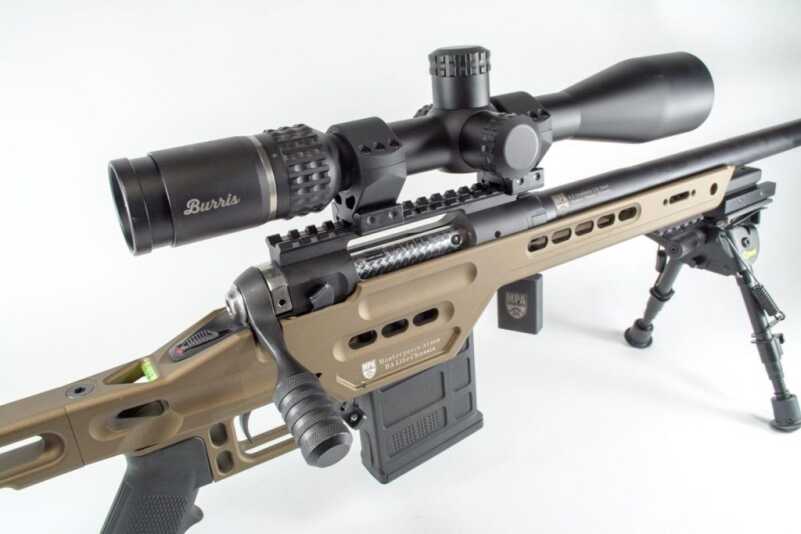
The Masterpiece Arms BA Lite PCR certainly lives up to its name. Shown here with a Burris Veracity 4-20x scope.
For more information, visit https://masterpiecearms.com.
To purchase a MasterPiece Arms BA series rifle on GunsAmerica.com, click this link: https://www.gunsamerica.com/Search.aspx?T=Masterpiece%20BA
You know what I love about the current trend in the shooting industry? Every year, there’s a new sport that’s all the rage. That’s great for growing the collective shooting sports and getting more and more people involved. Heck, it was just a few years back that 3-Gun didn’t even exist. One of the new(er) shooting sports on the scene is the Precision Rifle Series, or PRS for short. This is the sport where you see folks perched on things like simulated roofs trying to nail targets 1,000 or so yards down range. It’s a combination of skill, reloading science, equipment optimization, and big-time focus and concentration.

The Masterpiece Arms BA Lite PCR Rifle is designed to deliver on the competition field, and at a good price.
You can learn more about PRS here, but the reason I mention it is that the rifle we’re looking at today is purpose built for PRS. In fact, it’s purpose built for the production class of PRS. Any sport can quickly become an expensive equipment race, and PRS is no exception. To make PRS accessible to the more common man or woman, PRS created a Production Class. By rule, the rifle you use can’t cost more than $2,000, and the optic price is capped at $2,000. However, you can’t spend more than $3,000 on both combined. Before you get any ideas about post-purchase customization, Production Class rifles have to be in original and unmodified factory configuration. Now you know exactly why the MasterPiece Arms BA Lite PCR Competition Rifle retails for… $1,999.
SPECS
Chambering: 6.5 Creedmoor (.243 Win, .308 Win, 6.5×47 Lapua, 6mm Creedmoor, 6×47 Lapua also available)
Barrel: Bergara honed, stress relieved, profile customer choice; 22, 24, 25 or 26 inch
OA Length: Depends on barrel and adjustable length of pull settings
Weight: Chassis, 2.9 pounds; overall depends on barrel length and profile selected (13.5 pounds as tested)
Stock: MasterPiece Arms Light Weight BA Chassis produced from 6061 Aluminum, V-bedding system
Sights: 20 MOA Picatinny rail only
Action: Savage Model 12 Sporter Action with Floating Bolt Head Design
Finish: Cerakote finish, multiple colors available
Capacity: 10-round magazine included
MSRP: $1,999
The PCR Tour
I’m gonna get this out now so I can move on in a more subdued, rational, and professional manner. This MasterPiece Arms (MPA) rifle is impressive. When I opened the box of the PCR (which stands for “Production Class Rifle”) at my FFL, I floated into a state of rifle euphoria. And, the fact that it is from a company that made its name producing semi-automatic versions of stamped sheet steel SMGs makes it all the more impressive. This thing is gorgeous, which I guess makes sense given the name of the company, MasterPiece Arms. I mean, seriously, it’s a work of art. Not a detectable mark or blemish of any kind and every part marries perfectly to its neighbors. I guess one should expect that when you move into four-digit price territory, but even still. Wow. OK, now that it’s out of my system, we’ll get on with the program.
Starting with the business components, the action is a Savage Model 12 short action. I ordered this one in 6.5 Creedmoor, which seemed entirely appropriate given the intended use of this rifle. The barrel is a Bergara honed model made from 416R stainless steel. The 1:8 twist rate rifling is button cut. If you’re not familiar with Bergara barrels, they shoot exceptionally well for the price you pay. When examining the action, the first thing I noticed was the discreet gold engraved note on the chamber area: “6.5 Creedmoor, 1:8 twist, Chamber Throat: 140-grain Hornady A-Max/ELD.” You know the very first thing I did was order a pile of Hornady ELD bullets from Brownells, but we’ll get to that shortly. Of course, you can shoot most any other 6.5 bullets; the rifle is just “optimized” for that one.
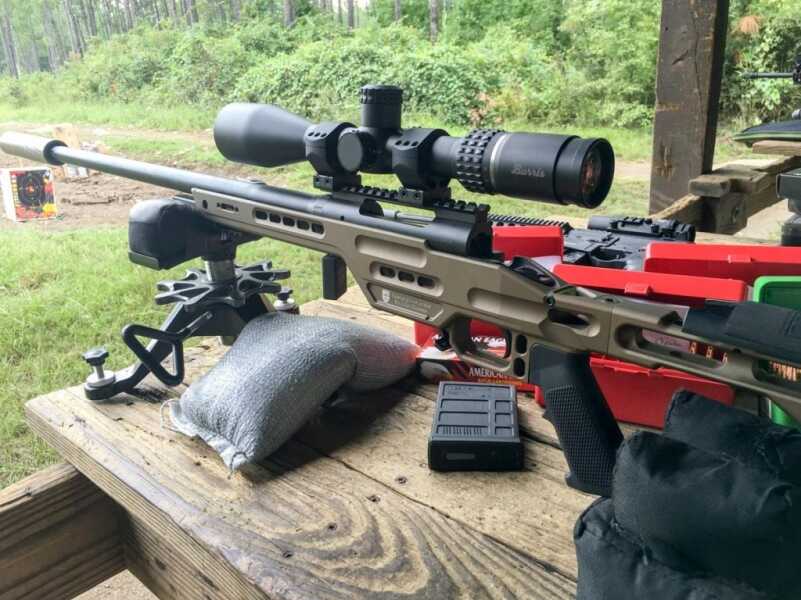
I did most of my shooting using the Thunder Beast Ultra 7 suppressor. Compact and light for a .30 caliber model, it did a great job of eliminating the blast.
The muzzle brake is an art form unto its own. Looking at it, you’d think it was for a .50 BMG rifle. I guess when you mount it on the massive bull barrel, it would look weird if it was any skimpier. Since it was about the biggest muzzle brake I’d ever seen on a rifle in this caliber range, I decided to weigh it using my wife’s digital kitchen scale. Don’t tell, OK? Anyway, it weighed in at a little over a third of a pound. Yeah! The design is kind of neat, too. Unlike standard brakes which are timed (oriented in the correct position, so the blast goes exactly to the sides) using crush or flat washers, this one uses a counter-rotating double threaded system. The large nut you see with the flat sides works as a locking nut, so you just adjust that to get correct alignment of the brake while you tighten it down. I thought that was a really nice touch that’s far more elegant than the crush washer approach you normally see on lesser rifles.
[one_half]
[/one_half]
[one_half_last]
[/one_half_last]
The trigger is made by Rifle Basix and is factory set for two pounds of press weight. It’s outstanding. It’s a single stage with virtually no detectable movement, and it breaks like the proverbial glass rod.
Moving to the stock, the receiver and fore-end are a single piece unit, while the buttstock is attached to the main body with two large hex screws. Moving from back to front, you’ll see that a soft Decelerator recoil pad is fixed to a floating aluminum base which can be moved front to back to adjust the length of pull. Similarly, a wide and well-rounded cheek rest, covered by soft foam, is adjustable up and down so you can set it for perfect cheek weld and eye alignment. On the PCR rifle, the adjustments for length of pull and cheek rest are done using hex screws. This is one of the cost-saving differences between the PCR and full-priced versions of other MPA bolt-action guns. Those have adjustments done by thumb wheels, so it’s easier to make tweaks while in the field or during a match.
[one_half]
[/one_half]
[one_half_last]
[/one_half_last]
On the bottom of the stock is a sand bag rider – basically a 3 1/2-inch smooth and flat-bottomed bar that provides a good surface for a rear rest and helps the stock from getting hung up on a rear bag rest during recoil. If you prefer, you can remove this piece and expose a mounting area for a rear monopod. Last, the buttstock has three different quick-detach sling swivel holes – on each side. This rifle is nothing if not modular; it’s got a million configuration options.
[one_half]
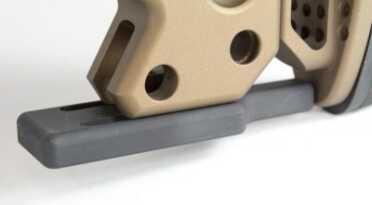
The bag rider helps keep the rifle on the rear sand bag during recoil. Underneath is a bipod attachment point.
[/one_half]
[one_half_last]
[/one_half_last]
Moving forward, there’s a built-in level directly above the pistol grip, so it’s literally right in front of your shooting side eye. For longer shots, just a little bit of angle can throw your shot off, so the level helps ensure a perfectly vertical hold. Under the level is a standard AR-15-type grip, so if you prefer a custom model, you can swap that out easily.
[one_half]
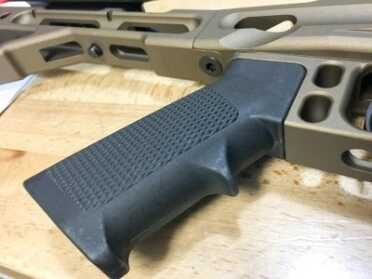
The use of a standard AR-15 grip means you can easily swap it for an aftermarket model of your choice.
[/one_half]
[one_half_last]
[/one_half_last]
Under the action is the mag well that on my 6.5 Creedmoor rifle housed an included 10-round 7.62×51 P-Mag. The magazine release is ambidextrous and operates by a slight push forward. I could easily reach it with my trigger finger without breaking my grip.
Over the action is a Picatinny rail. The rail is ramped down by 20 minutes of angle. The reason for this is that it handles much of the scope adjustment you would normally have to do for targets out in the 1,000-yard range. By “pre-adjusting” the rail, you save most of your internal scope adjustment capability. Otherwise, you run the risk bottoming out the internal scope elevation adjustment just to get on target at longer distances.
Just ahead of the magazine well, there is a series of 14 small round holes on the bottom edge of the fore-end. These are for the removable barricade stop. This is a metal piece a little smaller than a Zippo lighter that snaps into the desired hole via a spring loaded button. The barricade stop rotates freely, so after setting in the desired position, you can jam it up against something for stability and still rotate the gun laterally to get on target. It also makes a handy place to brace your support hand.
At the very front of the hand guard is a two-inch Picatinny rail segment for bipod attachment. The stock chassis also has a spigot mount location. Look at the photos to see it, but think of it as a way to mount a two-inch rail segment as far forward as possible and even closer to the barrel. This helps you get the gun as low as possible to the ground. The forward location provides more stability too. The sample rifle shown here has rails in both locations, but in practice, you would probably use one or the other depending on your preference. Oh, and right between these two rail locations is a pair of sling swivel quick-attach points, one on either side.
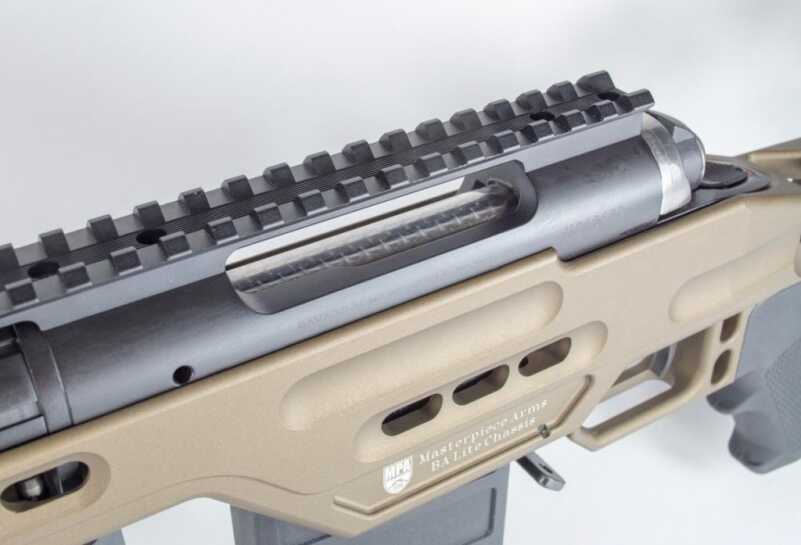
The Picatinny rail is ramped downward 20 minutes of angle to preserve internal scope adjustment for shot-to-shot changes.
This PCR has a burnt bronze Cerakote finish on the chassis, but you can also choose from black, flat dark earth, tungsten, or gunmetal as standard options.
Shooting the PCR
To keep true to the Production Class intended use of this rifle, I mounted a Burris Veracity 4-20x50mm optic. This one has a 30mm tube, and I used Burris XTR Signature Rings to mount it. That turned out to be a good move as we’ll see in a minute. Oh, the MSRP of the Veracity I used is $959, so I figured I was being consistent with the intent of PRS Production Class rules. Rings and scope mounts don’t count against your price limits.
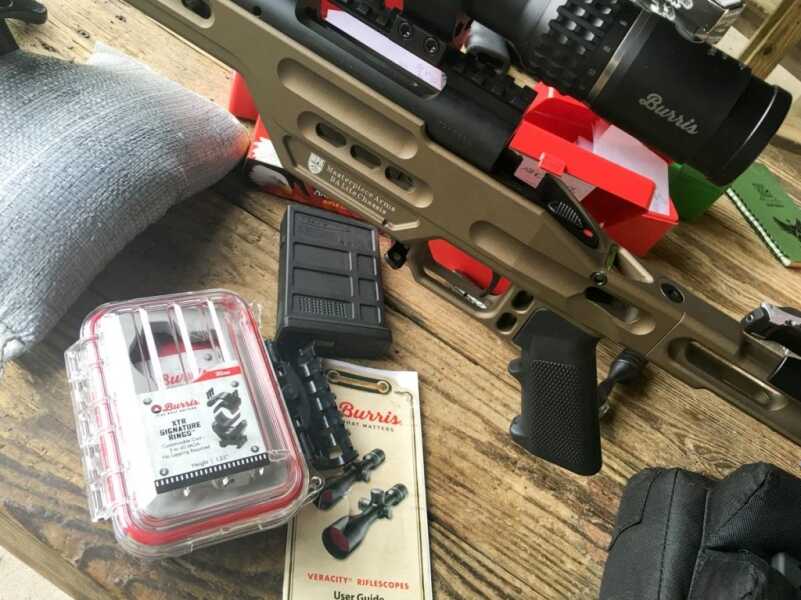
I mounted a Burris Veracity 4-20x50mm scope with Burris Signature XTR rings, putting the combination of rifle and optic just under the PRS Production Class rules price limit of $3,000.
The muzzle brake was kind of awesome. Recoil was pretty much non-existent, in part owing to the approximate total weight of 13.5 pounds including the scope and mounts. While that big brake helps with recoil too, it also makes a heckuva noise, which I have to admit was quite entertaining. Oh, you also get the benefit of a nice breeze in your face with every shot.
Thanks to my friends at Silencer Shop, I also shot this rifle quite a bit using a Thunder Beast Arms Ultra 7 .30-caliber suppressor. If you’re sticking with 6.5, Thunder Beast makes a model specific for that bore, too. I loved this suppressor. At just seven inches long and 9.8 ounces, it’s very light for a rifle can. It did an admirable job of negating the noise and blast, allowing me to focus on careful shooting.
MPA’s higher-end rifles have a 3/8 MOA three-shot group guarantee. The BA Lite PCR doesn’t explicitly state an accuracy guarantee that I could find, so I decided to see what it could do. Since this rifle was literally built for the Hornady 6.5mm 140-grain A-Max ELD bullet, I picked up a bunch of those I also got my hands on some Hornady 120-grain A-Max bullets just for good measure. Sticking with the Hornady theme, I bought new Hornady 6.5 Creedmoor brass and proceeded a load some variants using both bullet types.
I went to the range to do some accuracy testing with all of my carefully hand-crafted ammo and immediately ran into one of those “Doh!” moments. I had taken the Burris Veracity scope off another rifle and had forgotten that I was using Burris XTR Signature rings with adjustable inserts. To make a long story short, I had added in ten minutes of angle into the scope mount. That plus the 20 MOA ramped mount exceeded the adjustment range of my scope at the measly distance of just 100 yards, so my impacts were about 30 inches above my point of aim. No worries, when I got back from the range I reconfigured the adjustable shims to flatten out the built-in rail slope, thereby making the setup a little more friendly to 100-yard “short range” shooting.
Back for visit number two, I was right on target and able to do some accuracy work. A couple of things quickly became apparent. One, this rifle is a better shooter than I am, and two, the most minute environmental conditions can spoil the tiny groups that this rifle can print. Put differently, the rifle is so precise that things like bench vibration from nearby shooters and my own heartbeat caused flyers if you can even call a fraction of an inch off point of impact a flyer. Let me explain…
[one_half]
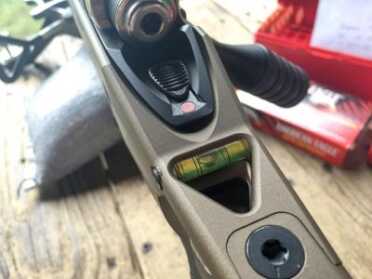
A built-in level in the stock is visible without breaking your firing position so you can be sure the rifle is perfectly oriented.
[/one_half]
[one_half_last]
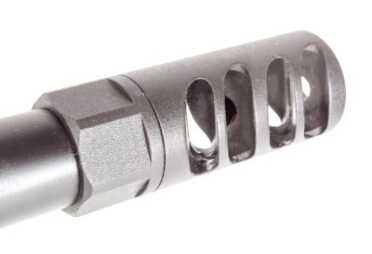
The muzzle brake made me happy. Weighing in at over 1/3 of a pound, it just looks massive – and appropriate.
[/one_half_last]
I quickly found that the PCR could print groups smaller than the movement caused by my own heartbeat. Cranking up the Burris Veracity to 20x, I noticed that a heartbeat would move my crosshairs somewhere between ¼ and ½ minute of angle, or ¼ to ½-inch at 100 yards. This turned into a fun shooting challenge as it caused me to up my game in terms of concentration. When I successfully shot between beats, I got single-hole or cloverleaf groups with most of the loads I tried. When I screwed that up, I got a “flyer” that “blew up” my group by a whopping fraction of an inch. That’s kind of funny to consider that a “blown group” but that’s what it was with this rifle. The other thing that was challenging was that this outdoor range has wooden shooting benches that are all connected by the support structure. When someone else moved on one of their tables or fired their gun, it would vibrate my table just enough to blow a group by a quarter or half-inch. This isn’t a problem I’ve had with other rifles as they’re simply not precise enough for that stuff to matter.
[one_half]
[/one_half]
[one_half_last]
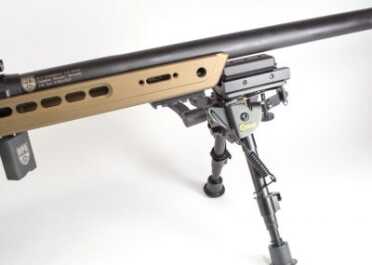
Here you can see the location of the spigot mount. It puts the bipod as far forward as possible and keeps the rifle low to the ground.
[/one_half_last]
For these reasons, I decided to do five shot groups instead of just three as the guarantee (for higher-end models) states, then I would report on best three. I figured this would be a fair way to factor out the environmental factors. Here’s what I got:
| Ammo | Velocity | Five Shots | Best Three Shots |
| Hornady 120-grain A-Max, 44.0 grains IMR 4350 | 2,981.3 fps | 1.01” | .38” |
| .69” | .43” | ||
| 1.14” | .39” | ||
| 1.3” | .35” | ||
| Hornady 120-grain A-Max, 38.5 grains Varget | 2,885.3 fps | .95” | .34” |
| .98” | .14” | ||
| Hornady 140-grain A-MAX ELD, 41.0 grains IMR 4350 | 2,780.3 fps | .72” | .29” |
| .85” | .34” | ||
| .76” | .35” | ||
| Hornady 140-grain A-MAX ELD, 35.0 grains Varget | 2,537.3 fps | .99” | .51” |
| 1.18” | .55” | ||
| American Eagle Open Tip Match 140-grain | 2,822.3 fps | .92” | .91” |
| .83” | .30” |
As you can see, I had to work kind of hard to get a three-shot group over ½-inch in diameter. When I was perfect, I watched shots land downrange touching each other. When I wasn’t, I’d get the fraction of an inch flyer. If you want to really see what it’s capable of, you’ll have to focus on your fundamentals, that’s for sure. There’s no built-in slop that’ll hide minor technique flaws, and that’s a good thing. If you do your job, this rifle will hit a dime every time at 100 yards. Doing the quick math, even with my worst groups would put every shot on a 10-inch plate at 1,000 yards.
[one_half]
[/one_half]
[one_half_last]
[/one_half_last]
Summing Things Up
An important takeaway is that MasterPiece Arms rifles are built to order, especially for you, and that counts this BA Lite PCR model, too. The sample rifle shown here came with most (if not all) of the options, like rails on both fore-end and spigot mount locations. If you like things set up differently, perhaps more sling instead of bipod mounts, just order it that way.
All said and done, this rifle is a beauty. Sure, you can buy lots of rifles that also shoot forward for a lot less money, but they won’t be in the same class. If you appreciate the difference between a Ford Taurus and a Corvette Grand Sport Z07, then you get the idea. I’ll buy one.
For more information, visit https://masterpiecearms.com.
To purchase a MasterPiece Arms BA series rifle on GunsAmerica.com, click this link: https://www.gunsamerica.com/Search.aspx?T=Masterpiece%20BA

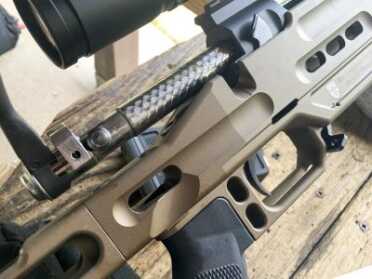
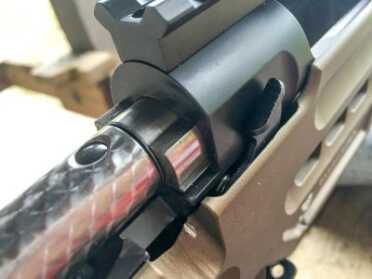
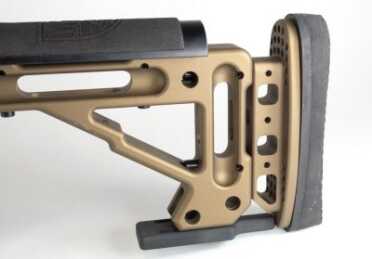
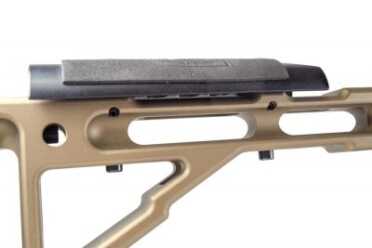
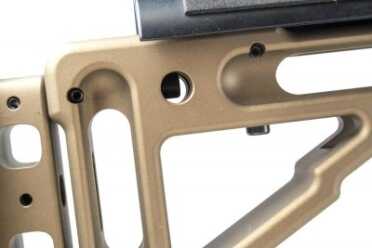
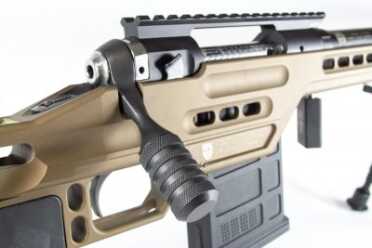
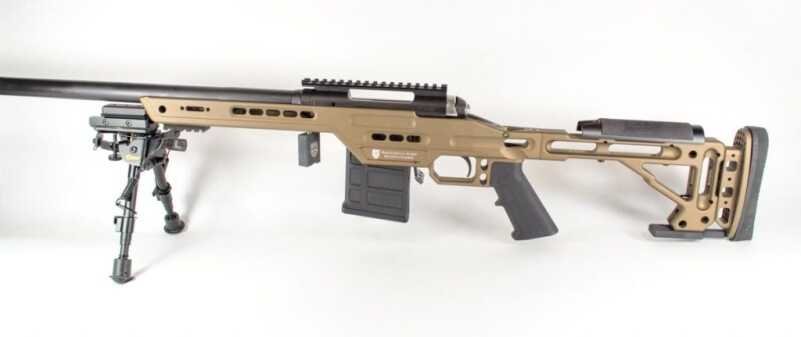
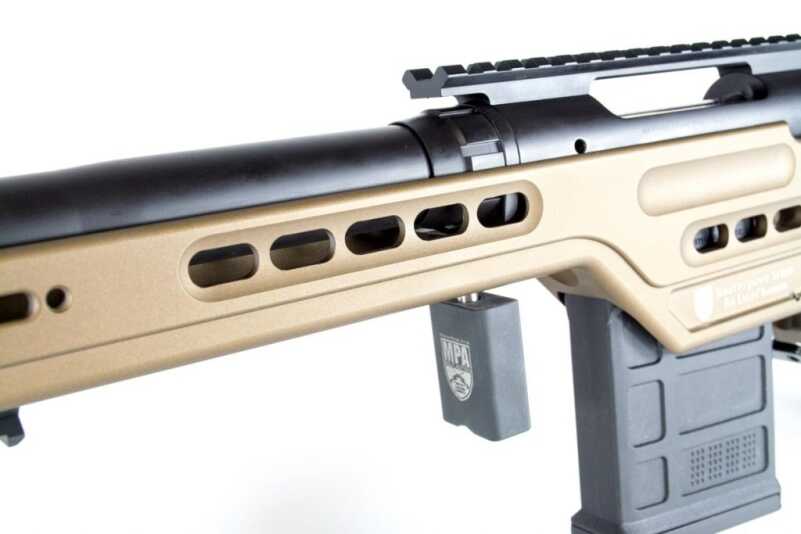
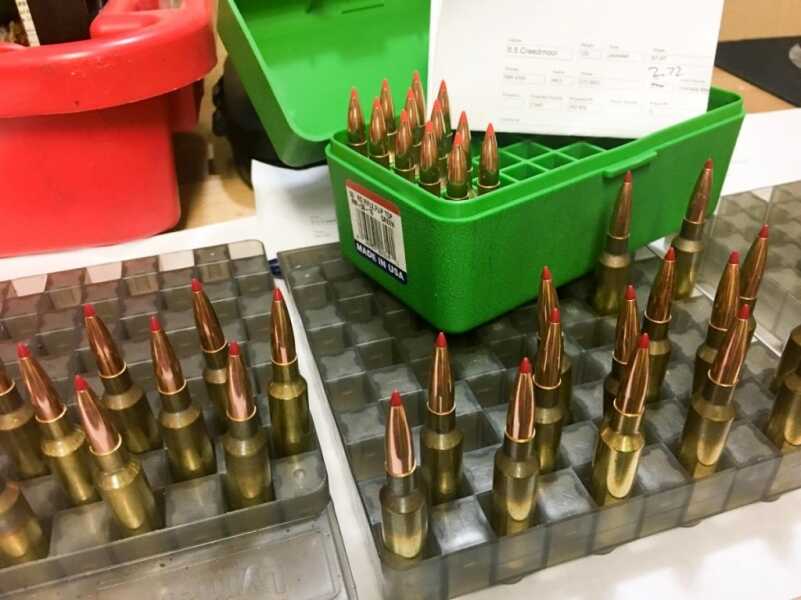
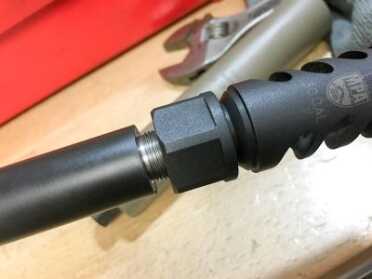
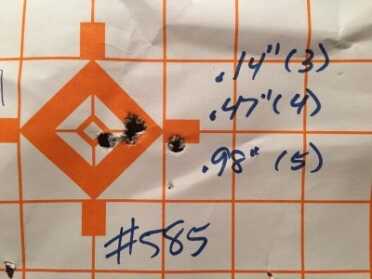
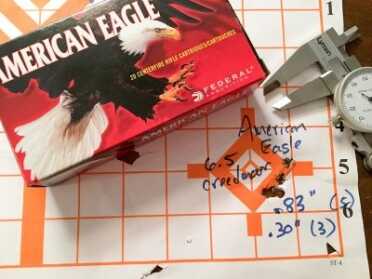
sounds like a nice shooter, When they make a 300 win mag version let me know,, sorry but 300 win mag is my favorite caliber for any range 100 to 1000 yards.. I am looking for a new silenced long range rifle that don’t cost $5000 & still can shoot better than me..
An article in this months Guns&Ammo “Combat Rifles says MASTERPIECE ARMSv (MPA) bought out Spencer Barrel company and their .308 model (308BA) is a button-rifled barrel from Spencer not a Bergara ! The article goes on to say the action is the Kelbly Atlast Tactical. It is a two lug with and I quote “almost a Remington 700 footprint but it would a little a little extra inletting to work with the Kelbly”. They also show the trigger breaks at 1 1/2 lbs but could be adjusted heavier. The 308BA model MSRP is $2999.00. Are they using different barrels and actions for 6.5 Creedmoor ???
is this rifle legal in nys
No: pistol grip, removable magazine, muzzle brake.